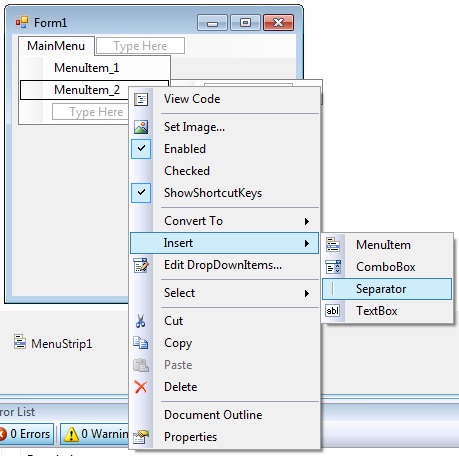


This version allows you to pass a ToolStripItem-type Versions uses the following syntax: member Add : This method is overloaded with various versions. To specify that a menu item will be part of a menuĬategory, call the Add() method of the ToolStripItemCollectionĬlass. Implements the IList and the ICollection interfaces. Property is of type ToolStripItemCollection, which aĬollection-based class: member DropDownItems : ToolStripItemCollection with get To support menu items, the ToolStripDropDownItemĬlass is equipped with a property named DropDownItems. The ToolStripDropDownItemĬlass is based on the ToolStripItem class. Provides functionality to other classes derived from it. This means that you cannot instantiate it. Let mnuEdit : ToolStripMenuItem = new ToolStripMenuItem() Let mnuFile : ToolStripMenuItem = new ToolStripMenuItem("File") If you had instantiated the class using its defaultĬonstructor, to specify its caption, the ToolStripMenuItem class isĮquipped with the Text property: abstract Text : string with get, set Let mnuFile : ToolStripMenuItem = new ToolStripMenuItem( "File") To specify the caption that will be displayed on a menuĬategory, you can use the following constructor of the ToolStripMenuItem Let mnuFile : ToolStripMenuItem = new ToolStripMenuItem() The default constructor is used to create a menu item ToolStripMenuItem class: type ToolStripMenuItem =ĭeclare a variable of the type of this class and initialize it using one of itsĬonstructors. Because the main menu is primarily aĬontrol, you must add it to the list of controls of the form. To create a main menu, declare a variable of type MenuStripĬlass and initialize it with its default constructor. To support menus for an application, the. To support actions that are used to graphically enhance theįunctionality of an application, the. In the same way, actions related to viewing documents can be listed under a View For example, actions that are related to file processing, such as creating a new file, opening an existing file, saving a file, printing the open file, or closing the file usually stay under a category called File. There is no strict rule on how a menu is organized. When clicked, the menu expands and displays a list of items that belong to that category. To use a menu, the user first clicks one of the words that displays on top. In WordPad, the categories of menus are File, Edit, View, Insert, Format, and In the top section of the form in which it is used.Ī main menu is divided in categories of items and each category is represented by a word. A menu is considered a main menu when it carries most of the actions the user can perform on a particular application. Of the mouse and the keyboard, there are various types of menus. To enhance the functionality of a graphical application, also to take advantage Menu is presented as a list of words and, using a mouse or a keyboard, the userĬan select the desired item from the menu. The user would then enter the number (or character) that corresponds to theĭesired option and continue using the program. On a typical DOS application, a menu is presented with numerical or character To be aware of these actions, the list must be presented to the user upon request. For a computer application, a menu is a list of actions that can be performed on that

When it comes to a restaurant, a menu is a list of food items that the business offers to its customers.


 0 kommentar(er)
0 kommentar(er)
